◄ Carnets Geol. 13 (L03) ►
Contents
[1. Introduction] [2. Geological background] [3. Systematics]
[4. Discussion] and ... [Bibliographic references]
Department of Geology, University of Tartu, Ravila 14A, EE-50411 Tartu (Estonia)
Manuscript online since July 22, 2013
[Editor and copy editor: Christian C. ; language editor: Stephen ]
Nine species of cornulitids are systematically described here from the Ordovician of Estonia. The earliest species, Cornulites semiapertus, appears in the late Darriwilian (Middle Ordovician), the next two species appear in the Sandbian and there are a further six new species in the Katian, which indicates a rapid diversification of cornulitids in the Late Ordovician of Baltica. All the studied cornulitids from the Ordovician of Estonia occur in relatively shallow-water normal-marine sediments of a carbonate platform. The cornulitids are found encrusting mostly brachiopod shells (both syn vivo and post mortem).
Tentaculita; Cornulitida; tubeworms; Ordovician; Baltica; Estonia.
O. (2013).- Cornulitid tubeworms from the Ordovician of eastern Baltic.- Carnets de Géologie [Notebooks on Geology], Brest, Letter 2013/03 (CG2013_L03), p. 131-138.
Tubes de cornulitides de l'Ordovicien de la Baltique orientale.- Neuf espèces de cornulitides provenant de l'Ordovicien d'Estonie sont décrites. La première espèce, Cornulites semiapertus, apparaît au Darriwilien terminal (Ordovicien moyen) et les deux suivantes au Sandbien ; enfin, on trouve six espèces au Katien, ce qui indique une diversification rapide des cornulitides au cours de l'Ordovicien supérieur en Baltique. Tous les cornulitides étudiés dans l'Ordovicien d'Estonie sont rencontrés dans des sédiments marins de plate-forme carbonatée peu profonde : ils y sont observés encroûtant essentiellement des coquilles de brachiopodes, de leur vivant ou post-mortem.
Tentaculita ; Cornulitida ; tubes ; Ordovicien ; Baltique ; Estonie.
Cornulitid tubeworms belong to the encrusting tentaculitoids. They are phylogenetically closely related to free-living tentaculitids ( & , 2009; , 2010). Their biological affinities have long been debated, but they most likely belong to the Lophothrochozoa ( & , 2012) and could represent stemgroup phoronids ( et al., 2010). They are palaeoecologically important as the hard substrate encrusters that generally retain their original position on the substrate after fossilisation ( & , 2003). Cornulitid tubeworms are found only in normal marine sediments, which differs from their close relatives, the microconchids, that lived in waters of various salinities ( et al., 2012). Cornulitid tubeworms are common in shallow marine sediments, especially those associated with carbonate platforms. They have a stratigraphic range from the Middle Ordovician to the Late Carboniferous (, 2010). Cornulitids had a diverse ecology with six adaptive strategies thus far described (, 2010).
Cornulitids of the eastern Baltic are poorly studied, mostly due to their minor stratigraphical importance caused by taxonomic uncertainties. The earliest records of cornulitids from Estonia are by (1858) and (1860). Recently several new taxa of cornulitids have been described from the Late Ordovician ( & , 2012a) and Silurian ( & , 2010) of Estonia. The cornulitids have usually been treated as the minor group in the Ordovician of Estonia. However, their abundance as encrusters on various shelly fossils and hardgrounds, especially in the Silurian, is remarkable ( & , 2010). Most of the cornulitid species here are described in open nomenclature because of the small number of well-preserved specimens available for study. The majority of Ordovician cornulitid species have been described from North America. These mostly 19th Century species need to be revised before one can attempt to identify them in the Ordovician of Baltica.
All the specimens used in this study are housed at the Natural History Museum (Museum of Geology), University of Tartu (TUG), and in the Institute of Geology, Tallinn University of Technology (GIT), Estonia.
The aims of the paper are to: 1) systematically describe the encrusting cornulitid tubeworm fauna from the Estonian Ordovician for the first time, and 2) discuss the diversity, ecology and stratigraphic distribution of Ordovician cornulitid tubeworms in Estonia.
A shallow epicontinental sea covered what will become modern Estonia in the Ordovician (Fig. 1 ![]() ). The Ordovician sequence is relatively complete and represented mostly by carbonate rocks except for the terrigenous Lower Ordovician sequence (Fig. 2
). The Ordovician sequence is relatively complete and represented mostly by carbonate rocks except for the terrigenous Lower Ordovician sequence (Fig. 2 ![]() ). Ordovician limestones are exposed in northern Estonia as a wide belt from the Narva River in the east to Hiiumaa Island in the west ( & ,
2007). The eastern Baltic climate changed drastically during the Ordovician when Baltica drifted from the southern high latitudes to the tropical realm ( & ,
1990; et al.,
1992). The warming of the climate induced an increase in the sedimentation rate of carbonates. Deposits that are characteristic of an arid and tropical climate appeared in the sequence ( & ,
2007). These types of deposits were totally lacking in the Early and Middle Ordovician when the Baltic Basin was situated in a temperate climate zone (,
1973). The first signs of warm climate (appearance of tabulate corals, stromatoporoids and reefs) are early Katian, but it was not until the very end of the Ordovician (Hirnantian) that they became prevalent ( & ,
2007).
). Ordovician limestones are exposed in northern Estonia as a wide belt from the Narva River in the east to Hiiumaa Island in the west ( & ,
2007). The eastern Baltic climate changed drastically during the Ordovician when Baltica drifted from the southern high latitudes to the tropical realm ( & ,
1990; et al.,
1992). The warming of the climate induced an increase in the sedimentation rate of carbonates. Deposits that are characteristic of an arid and tropical climate appeared in the sequence ( & ,
2007). These types of deposits were totally lacking in the Early and Middle Ordovician when the Baltic Basin was situated in a temperate climate zone (,
1973). The first signs of warm climate (appearance of tabulate corals, stromatoporoids and reefs) are early Katian, but it was not until the very end of the Ordovician (Hirnantian) that they became prevalent ( & ,
2007).
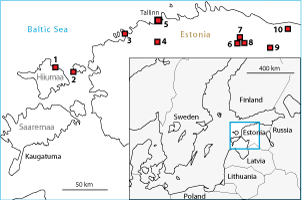
Cliquer
sur la miniature pour agrandir l'image
[Click on thumbnail to enlarge the image]
Figure 1: Map showing the location of study area and the localities. 1: Kärdla, Hiiumaa Island; 2: Hosholm, Vormsi Island; 3: Männiku, Pakri peninsula; 4: Üksnurme; 5: Kadaka, Tallinn; 6: Rakvere; 7: Rägavere; 8: Tõrremägi; 9: Oandu; 10: Kohtla.
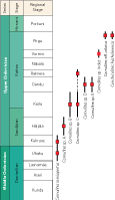
Cliquer
sur la miniature pour agrandir l'image
[Click on thumbnail to enlarge the image]
Figure 2: Stratigraphic location of samples. Squares mark samples and bars indicate their possible stratigraphic age.
Phylum Incertae Sedis
Class Tentaculitida , 1964
Order Cornulitida , 1964
Family Cornulitidae , 1962
Genus Cornulites , 1820
Cornulites ? semiapertus , 1930
1930 Cornulites semiapertus sp.n. – , p. 8-10, Fig. 4-7; Pl. 1, fig. 1.
2010 Cornulites semiapertus – , p. 130, Fig. 1A-B.
Material: Five complete tubes and one tube fragment from Kohtla, NE Estonia. One complete tube from Kadaka road cut, North Estonia (Fig. 1 ![]() ).
).
Stratigraphy: From Uhaku (upper Darriwilian) to Kukruse Stage (lower Sandbian) (Fig. 2 ![]() ).
).
Notes: Tubicolous shells have a length 3.0 to 10.0 mm with apertures diameter 1.3 to 3.2 mm. They are externally and internally covered by prominent, sharp, perpendicular annulation (*). There are unevenly developed faint perpendicular growth lines (0.1-0.12 mm in wide) between the external annuli. The interior annulation does not always correspond to that on the exterior, so two external annuli can correspond to single internal annulus. Longitudinal striae are lacking. Tube wall contains vesicles.
(*): Annulation refers to these growth features perpendicular to the axis of elongation of the tube which cannot be misinterpreted as growth lines because the latter are much finer.
Remarks: This species lacks the longitudinal striation diagnostic of the genus (, 1962). Thus, the species can only be tentatively assigned to the genus Cornulites. Five specimens attached to a brachiopod and one to trilobite head shield.
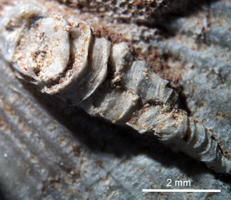
Cliquer
sur la miniature pour agrandir l'image
[Click on thumbnail to enlarge the image]
Figure 3: Cornulites semiapertus , 1930, Kukruse stage, Sandbian, Kohtla, NE Estonia. TUG 1053-28.
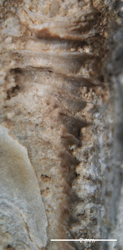
Cliquer
sur la miniature pour agrandir l'image
[Click on thumbnail to enlarge the image]
Figure 4: Cornulites semiapertus , 1930, Uhaku stage, Darriwilian, Kadaka road cut, Tallinn, North Estonia. TUG 1383-1.
Cornulites aff. celatus , 2010
2012a Cornulites aff. celatus - & , p. 4-6, Fig. 2E–H.
2012b Cornulites aff. celatus - & , p. 139, Fig. 3A-C.
Material: Thirteen specimens inside the lumen
of Protoheliolites dubius, 13 specimens inside the
lumen of Propora speciosa and four specimens inside the lumen
of Stelliporella parvistella from Hosholm locality, Vormsi Island (Fig. 1 ![]() ).
).
Stratigraphy: Pirgu Stage, Adila Formation, D. anceps Biozone, Katian, Upper Ordovician (Fig. 2 ![]() ).
).
Remarks: This species has only been found endosymbiotically in tabulate corals. Divergence angle of tubes is 4–6.5º. Tube wall 0.1–0.3 mm thick, vesicular in apertural part. Tube wall structure microlamellar. Tube interior covered by sharp well-developed annulation. Tube's external surface may show perpendicular ridges.

Cliquer
sur la miniature pour agrandir l'image
[Click on thumbnail to enlarge the image]
Figure 5: Cornulites aff. celatus, Pirgu Stage, Adila Formation, D. anceps Biozone, Katian, Upper Ordovician, Hosholm, Vormsi Island, NW Estonia. GIT 520-140-1.
Cornulites sp. A
Material: Two complete shells.
Locality: Männiku Farm, Pakri peninsula, NW Estonia (Fig. 1 ![]() ).
).
Stratigraphy: Haljala Stage, Kahula Formation, Sandbian, Upper Ordovician (Fig. 2 ![]() ).
).
Description: Straight tubicolous shells have a length 5.5 to 6.0 mm with aperture diameter 1.0 to 1.1 mm. Whole tube attached to the substrate. Tube divergence angle is 9-10º. They are externally and internally covered by well-developed, ring-like, perpendicular annulation at the interval 0.5-0.6 mm near the aperture. Tubes have annulated lumen. Tubes are covered with very faint weakly developed longitudinal striation about 10 striae per 1 mm. Tube base not widened.
Remark: Both specimens are attached to the strophomenid brachiopod Astamena inaequalis. The apertures of C. sp. A are oriented towards the anterior commissure of the brachiopod. This may indicate a syn vivo encrustation by cornulitids, as cornulitids could have taken advantage of feeding currents produced by the brachiopod.
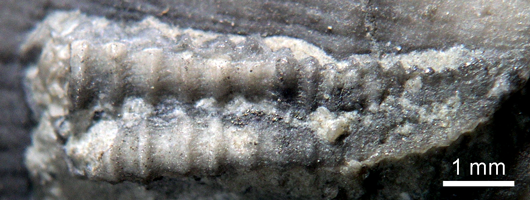
Cliquer
sur la miniature pour agrandir l'image
[Click on thumbnail to enlarge the image]
Figure 6: Cornulites sp. A., Männiku, Pakri peninsula, NW Estonia, Haljala Stage, Kahula Formation, Sandbian, Upper Ordovician. TUG 76-44.
Cornulites sp. B
Material: One complete shell, one partially preserved tube fragment.
Locality: Oandu, NW Estonia (Fig. 1 ![]() ).
).
Stratigraphy: Keila Stage, Kahula Formation, upper Sandbian, Upper Ordovician (Fig. 2 ![]() ).
).
Description: Moderately curved tubicolous shells entirely attached to the substrate. The tube length is about 20 mm and diameter of the aperture is 4.7 mm. Tube grew relatively fast in diameter. Tube divergence angle is about 14º. External surface of the tube is covered with weakly developed irregular perpendicular annulation and irregular perpendicular growth lines of variable development. There are 3 to 4 growth lines per 1 mm near the aperture. The tube exterior is covered with well-developed regular longitudinal striae, about 5-6 striae per 1 mm near the aperture. The tube lumen is covered with well-developed annuli, about 2 to 2.2 mm wide near the aperture. The annulation of the lumen is weakly developed at the substrate-cemented side of the tube. There are a few possible vesicles in the tube wall.
Remarks: One C. sp. B is attached to the dorsal valve of strophomenid brachiopod Pauciruga viruana near the commissure of the brachiopod. The other specimen is on the ventral valve also near the commissure of the brachiopod.
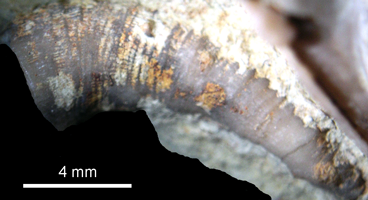
Cliquer
sur la miniature pour agrandir l'image
[Click on thumbnail to enlarge the image]
Figure 7: Cornulites sp B. Oandu, NW Estonia, Keila Stage, Kahula Formation, upper Sandbian, Upper Ordovician. TUG 1383-4.
Cornulites sp. C
Material: Four complete shells.
Locality: Rakvere (three shells), Rägavere (one shell), NE Estonia (Fig. 1 ![]() ).
).
Stratigraphy: Keila Stage to Rakvere Stage, Katian, Upper Ordovician (Fig. 2 ![]() ).
).
Description: Straight to moderately curved tubicolous shells. Tubes are 13 to 15 mm long and 3.0 to 4.0 mm wide at the aperture. The divergence angle of the tubes is about 12º. Tubes covered externally with relatively regular annulation. The tubes ornament is composed of well-developed regular longitudinal striae and well-developed relatively regular perpendicular growth lines. The growth lines are slightly coarser than the striae. There are 11 to 12 striae per 1mm and 4 to 5 growth lines per 1 mm near the aperture. The interior of tubes is covered with well-developed regular annulation with sharp crests. Tube wall is vesicular at the annular crests. The distance between annular crests is about 1.7 mm at the tubes diameter 4 mm. The basal edge is not widened.
Remarks: Tubes detached from the substrate. One tube seems to have a relatively long free (unattached) part.

Cliquer
sur la miniature pour agrandir l'image
[Click on thumbnail to enlarge the image]
Figure 8: Cornulites sp. C, Rakvere, NE Estonia, Keila Stage, Katian, Upper Ordovician. TUG 1383-5.
Cornulites ? sp. D
Material: One complete shell, one partially preserved fragment.
Locality: Üksnurme, North Estonia (Fig. 1 ![]() ).
).
Stratigraphy: Oandu Stage, Vasalemma Formation, Saku Member, Katian, Upper Ordovician (Fig. 2 ![]() ).
).
Description: Moderately curved tubicolous shells entirely attached to substrate. Tube length is about 6 mm and maximal diameter is about 0.8 mm. Tubes divergence angle 8º. Tubes are externally covered with somewhat irregular, but laterally prominent annulation and fine weakly developed perpendicular growth lines. At the contact with substrate annular ridges protruding from the tube wall, otherwise tubes base not widened. The longitudinal striae are absent. Tube lumen is annulated.
Remarks: This species lacks the longitudinal striation diagnostic of the genus (, 1962). Thus, the species can only be tentatively assigned to the genus Cornulites. Two specimens are attached to the interior of ventral valve of brachiopod Clinambon sp.
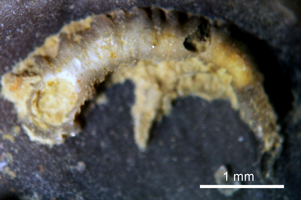
Cliquer
sur la miniature pour agrandir l'image
[Click on thumbnail to enlarge the image]
Figure 9: Cornulites sp. D. Üksnurme, North Estonia, Oandu Stage, Vasalemma Formation, Saku Member, Katian, Upper Ordovician. TUG 1383-6.
Cornulites ? sp. E
Material: One partially preserved shell.
Locality: Tõrremägi, NE Estonia (Fig. 1 ![]() ).
).
Stratigraphy: Oandu Stage, Katian, Upper Ordovician (Fig. 2 ![]() ).
).
Description: Free part of the tube is almost straight. Tube is growing relatively fast in diameter. Tubes divergence angle about 12 º. Tube is externally covered with irregular perpendicular growth lines of various development, but without clear annulation. Longitudinal striae are absent. Tube wall is relatively thick and completely vesicular. Tubes lumen is covered with fine annulation. The annuli are 0.4 to 0.5 mm wide at the tube diameter of 4.0 mm.
Remarks: This species lacks the longitudinal striation diagnostic of the genus (, 1962). Thus, the species can only be tentatively assigned to the genus Cornulites. The specimen has a shell repair mark that possibly indicates a failed predatory attack.

Cliquer
sur la miniature pour agrandir l'image
[Click on thumbnail to enlarge the image]
Figure 10: Cornulites sp. E. Tõrremägi, NE Estonia, Oandu Stage, Katian, Upper Ordovician. Arrow points to a shell repair mark. TUG 1383-3.
Cornulites sp. indet.
Locality: Kärdla, Hiiumaa, NW Estonia (Fig. 1 ![]() ).
).
Stratigraphy: Vormsi Stage, Katian, Upper Ordovician (Fig. 2 ![]() ).
).
Remarks: Poorly preserved tubicolous shells about 7 mm long completely attached to a gastropod Trochonema sulcifera. Shells covered with perpendicular ridges.
Genus Conchicolites , 1872
Conchicolites hosholmensis & , 2012a
2012a Conchicolites hosholmensis & , Fig. 2A–D, p. 3-4.
Material: Three specimens in tabulate coral Protoheliolites dubius.
Locality: Hosholm, Vormsi Island, NW Estonia (Fig. 1 ![]() ).
).
Stratigraphy: Pirgu Stage, Adila Formation, D. anceps Biozone, Katian, Upper Ordovician (Fig. 2 ![]() ).
).
Remarks: The species has the smooth tube lumen characteristic of the genus Conchicolites. Their endobiotic tubes are embedded in coral skeleton with aperture on the coral surface. The tubes are very thin-walled covered with ultra-fine transverse sculpture. There are concave, smooth tabulae in the apical region.
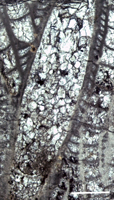
Cliquer
sur la miniature pour agrandir l'image
[Click on thumbnail to enlarge the image]
Figure 11: Conchicolites hosholmensis & , 2012a, Hosholm, Vormsi Island, NW Estonia, Pirgu Stage, Adila Formation, D. anceps Biozone, Katian, Upper Ordovician. GIT-520-242-1.
Diversity
There is just one species of cornulitid, C. semiapertus, known
from the Middle Ordovician of Estonia (Fig. 2 ![]() ). In the Late Ordovician of Estonia the number increases to two genera with nine species (Fig. 2
). In the Late Ordovician of Estonia the number increases to two genera with nine species (Fig. 2 ![]() ). There
is one species in the Darriwilian, three in the Sandbian and six in the Katian. These numbers indicate a rapid diversification of cornulitids in the Late Ordovician of Baltica. The taxonomy of cornulitids from the other palaeocontinents is poorly known and does not allow speculation as to whether the species described here originated in Baltica or migrated here from elsewhere.
). There
is one species in the Darriwilian, three in the Sandbian and six in the Katian. These numbers indicate a rapid diversification of cornulitids in the Late Ordovician of Baltica. The taxonomy of cornulitids from the other palaeocontinents is poorly known and does not allow speculation as to whether the species described here originated in Baltica or migrated here from elsewhere.
The diversity data on cornulitid tubeworms from the Ordovician of Estonia are poor. However, the sketchy data here are consistent with the rapid global generic diversification of cornulitid tubeworms in the Ordovician (, 2010).
In general, cornulitids seem to be relatively rare in the Late Ordovician of Baltica, which contrasts with the situation in the Late Ordovician of North America where cornulitids seem to be more common (, 1974). Further studies should determine whether the diversity and number of cornulitids was actually higher in North America than in Baltica during the Late Ordovician.
Ecology
All the studied cornulitids from the Ordovician of Estonia occur in normal marine shelf sediments of a carbonate platform. It is difficult to reconstruct the depth distribution of the cornulitids in the Ordovician of Estonia because exact data on palaeodepth are absent. However, the studied material is derived from north Estonia, which was covered with a relatively shallow sea during the Middle and Late Ordovician. The cornulitids encrusted hard organic substrates in various sedimentation environments such as mud bottom (both carbonate and clay), and organic rich carbonate mud bottom (oil shale).
Most cornulitids encrust brachiopods in the Ordovician of Estonia, but this probably represents a sampling bias and not true preference by cornulitids. The brachiopod shells were often encrusted post mortem (indicated by cornulitids in the interiors), but multiple oriented cornulitids on brachiopods (externally) may represent syn vivo encrustation. In the latter case the cornulitids could have taken advantage of feeding currents produced by the host brachiopod (, 1974).
In the Katian the earliest endobiotic coral symbionts appeared among cornulitids ( & , 2012b) in the Ordovician. The exact nature of these symbiotic associations is not known; either mutualism or parasitism is possible. The endobiotic coral symbionts evolved among cornulitids probably in response to increased predation pressure. The earliest signs of failed predation on cornulitids are known from the Katian of Baltica (, 2009).
Stratigraphic distribution
The fossils of cornulitids are known from the Uhaku Stage (Darriwilian) to Pirgu Stage (late Katian) in Estonia (Fig. 2 ![]() ). They will probably be discovered from the Hirnantian, too, when an adequate number of substrates have been studied. Some species could be characteristic of narrower stratigraphic intervals, such as the C. semiapertus for Kukruse and Uhaku stages, C. sp A. for Haljala Stage, and C. sp. B for Keila Stage (Fig. 2
). They will probably be discovered from the Hirnantian, too, when an adequate number of substrates have been studied. Some species could be characteristic of narrower stratigraphic intervals, such as the C. semiapertus for Kukruse and Uhaku stages, C. sp A. for Haljala Stage, and C. sp. B for Keila Stage (Fig. 2 ![]() ). The coral endobiont Cornulites aff celatus and Conchicolites hosholmensis are characteristic of the upper Pirgu Stage (Fig. 2
). The coral endobiont Cornulites aff celatus and Conchicolites hosholmensis are characteristic of the upper Pirgu Stage (Fig. 2 ![]() ). The known stratigraphic distribution of cornulitid tubeworms in the Ordovician of Estonia has numerous gaps, but these gaps presumably represent the collecting bias rather than the actual absence of cornulitids in the section.
). The known stratigraphic distribution of cornulitid tubeworms in the Ordovician of Estonia has numerous gaps, but these gaps presumably represent the collecting bias rather than the actual absence of cornulitids in the section.
Financial support was provided by the Paleontological Society through a Grant, Estonian Science Foundation grant ETF9064 and the Estonian Ministry of Education and Science through the target project SF0180051s08 (Ordovician and Silurian climate changes, as documented from the biotic changes and depositional environments in the Baltoscandian Palaeobasin). This paper is a contribution to IGCP 591 "The Early to Middle Palaeozoic Revolution". I am grateful to M.A. and an anonymous reviewer for their constructive reviews.
B. (1964).- The Tentaculites of Bohemia: their morphology, taxonomy, ecology, phylogeny and biostratigraphy.- Czechoslovak Academy of Sciences, Praha, 215 p.
E.
(1860).- Lethaea Rossica ou
Paléontologie de la Russie, décrite et figurée. Premier Volume. Seconde Section de l'ancienne Période.- Schweizerbart, Stuttgart, p. 1066-1188.
online: http://gallica.bnf.fr/ark:/12148/bpt6k97460g
D.W. (1962).- Small conoidal shells of uncertain affinities. In: C.D. (ed.), Treatise on Invertebrate Paleontology, Geological Society of America, New York; University of Kansas, Lawrence, Part W, p. 130–143.
V. (1973).- Aspects of carbonate sedimentation in the Ordovician of Baltoscandia.- Lethaia, Oslo, vol. 6, p. 11–34.
M.A. & O. (eds., 2007).- Excursion Guidebook. In: 10th International Symposium on Fossil Cnidaria and Porifera. Excursion B2: Lower Paleozoic geology and corals of Estonia. August 18-22, 2007.- Institute of Geology at Tallinn University of Technology, 66 p.
H.A. (1872).- On the genera Cornulites and Tentaculites and a new genus Conchicolites.- American Journal of Science, New Haven, vol. 3, p. 202–206.
A. (1930).- Beiträge zur kenntnis der Kukruse-(C2-C3-) Stufe in Eesti.- Publications of the Geological Institution of the University of Tartu, vol. 24, p. 8–10.
A. (1867).- Handbuch der Petrefaktenkunde. 2. Auflage.- Laupp'sche Buchhandlung, Tübingen, 982 p.
P.R. (1974).- Ecology of the Cornulitidae.- Journal of Paleontology, Tulsa, vol. 48, p. 514–523.
C.R. & W.S. (1990).- Revised world maps and introduction. In: W.S. & C.R. (eds), Palaeozoic palaeogeography and biogeography.- The Geological Society of London, Memoirs, n° 12, p. 1-21.
E.F. von (1820).- Die Petrefaktenkunde auf ihrem jetzigen Standpunkte durch die Beschreibung seiner Sammlung versteinerter und fossiler Überreste des Thier- und Planzenreichs der Vorwelt erläutert.- Becker'sche Buchhandlung, Gotha, 436 p.
F. (1858).- Untersuchungen über die silurische Formation von Estland, Nord-Livland und Öesel.- Archiv für die Naturkunde Liv- Ehst- und Kurlands, Tartu, (Serie 1), 248 p.
P.D. & M.A. (2003).- Palaeoecology and evolution of marine hard substrate communities.- Earth Science Reviews, Amsterdam, vol. 62, p. 1–103.
P.D., O. & M.A. (2010).- Evolution of biomineralization in "lophophorates".- Special Papers in Palaeontology, London, vol. 84, p. 317-333.
T. H., M. A., van der R., A., N. & E. (1992).- Baltica. A synopsis of Vendian–Permian palaeomagnetic data and their palaeotectonic implications.- Earth-Science Reviews, Amsterdam, vol. 33, p. 133–152.
O. (2009).- Attempted predation on Early Paleozoic cornulitids.- Palæogeography, Palæoclimatology, Palæoecology, Amsterdam, vol. 273, p. 87-91.
O. (2010).- Adaptive strategies in the evolution of encrusting tentaculitoid tubeworms.- Palæogeography, Palæoclimatology, Palæoecology, Amsterdam, vol. 292, p. 211–221.
O. & M.-A. (2012a).- New endobiotic cornulitid and Cornulites sp. aff. Cornulites celatus (Cornulitida, Tentaculita) from the Katian of Vormsi Island, Estonia.- GFF, Stockholm, vol. 134, p. 3-6.
O. & M.-A. (2012b).- Diverse early endobiotic coral symbiont assemblage from the Katian (Late Ordovician) of Baltica.- Palæogeography, Palæoclimatology, Palæoecology, Amsterdam, vol. 321–322, p. 137–141.
O. & H. (2009).- Calcareous tubeworms of the Phanerozoic.- Estonian Journal of Earth Sciences, Tallinn, vol. 58, p. 286–296.
O. & M.A. (2010).- Endosymbiotic Cornulites in the Sheinwoodian (Early Silurian) stromatoporoids of Saaremaa, Estonia.- Neues Jahrbuch für Geologie und Paläontologie, Abhandlungen, Stuttgart, vol. 257, p. 13-22.
O. & M. (2012).- Phenetic phylogenetics of tentaculitoids — extinct problematic calcareous tube-forming organisms.- GFF, Stockholm, vol. 134, p. 145-156.
M., O. & M. (2012).- Invasion of freshwater and variable marginal marine habitats by microconchid tubeworms - an evolutionary perspective.- Geobios, Lyon, vol. 45, p. 603-610.